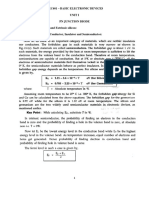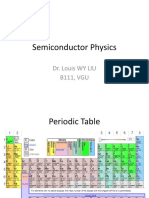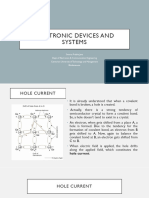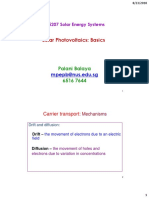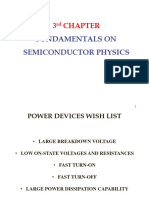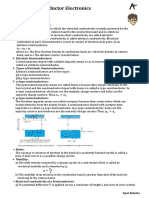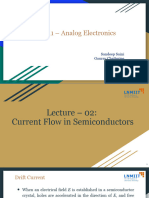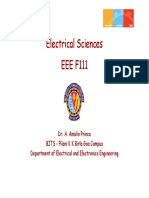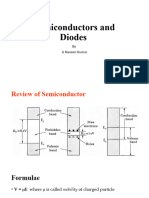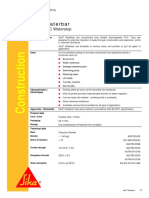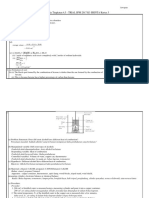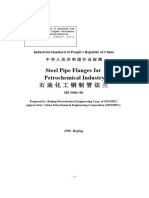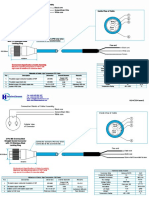UNIT-II
R.RADHA KRISHNA
B.E.,M.Tech,M.B.A,(Ph.D),AMIETE.
��N - TYPE SEMICONDUCTOR:
Fig: Current in n- type Semiconductors
�P - TYPE SEMICONDUCTOR:
�Fig: Current in P- type Semiconductors
�GENERATION AND RECOMBINATION OF CHARGES
The rate of change of hole density is
equal to rate of generation minus the rate
at which they recombine with electrons.
Thus,
and G and R are the generation and recombination rates
for the minority carriers.
R=
��CURRENTS IN THE SEMICONDUCTOR MATERIAL
DRIFT AND DIFFUSION CURRENTS:
The flow of charge i.e. current, through a
semiconductor material are of two types,
namely Drift and diffusion.
The net current flow through a PN junction
diode also has two components (1) Drift
current (2) Diffusion current
�DRIFT CURRENT
When an electric field is applied across
the semiconductor material, the charge
carriers attain a certain drift velocity V d.
Which is equal to the product of the
mobility of the charge carriers and the
applied electric field intensity E.
(or)
Drift current arises due to potential
gradient (due to applied voltage)
� The equation for the drift current density J n, due
to free electrons is given by
�DIFFUSION CURRENT
Diffusion current arises due to concentration
gradient.
Since the hole density p(x) decreases with increasing x as
shown in Fig. ,dp/dx is negative and the minus sign in the
above equation is needed in order that Jp has a positive
sign in the positive x-direction.
�Total Current :
The total current in a semiconductor is the sum of drift current
and diffusion current. Therefore, for a P-type semiconductor, the
total current per unit area, i.e. the total current density is given by
Similarly, the total current density for an N-type semiconductor is
given by
�Fig:(a) Excess hole concentration varying along
the axis in an N-type semiconductor bar
�Fig:(b) the resulting diffusion current
�Einstein Relationship for Semiconductor:
The equation which relates the mobility and the diffusion
coefficient D is known as the Einstein Relationship.
The importance of Einstein relationship is that it can be
used to determine Dp (or Dn), if the mobility of holes (or
electrons) is measured experimentally
Ex:For an intrinsic silicon,
Dp = 13 cm2/s and Dn = 34 cm2/s. For an intrinsic
germanium, Dp = 47 cm2/s and Dn = 99 cm2/s
�Diffusion Length (L):
The average distance that on excess charge
carrier can diffuse during its life time is called the
diffusion length L, which is given by
where D is the diffusion coefficient
�CONTINUITY EQUATION:
The continuity equation gives the dependence of
the current components on time as well as space.
This equation is very useful in formulation the
current equation of any device, in particular the
p-n junction diode.
Assume a differential volume of n type material of
thickness x and cross section of 'A'.
Let the current due to electron entering the
volume is In and current leaving is In + dIn after
flowing across the volume for a length of x.
Let n be the concentration of the electron in the
material.
� Now, since the current leaving the material, I n +
dIn is large compared to current In entering the
device, charge carriers in the device are decreasing
with in the volume.
Since the magnitude of charges is q, dIn/q is the
number of electron per second with in the volume.
Thus the electron concentration per second can be
given as
�Fig: Relating to continuity equation
� The magnitude of the carrier charge is q, then dIp/q
equals the decrease in number of holes per second
within the elemental volume A x. As the current
density Jp=Ip/A
R = p/p due to recombination but charge can neither
created nor destroyed, Hence, increase in holes per unit
volume per second, must equal the algebraic sum of all the
increases 'in hole concentration. Thus,
� This is the Continuity equation or equation of Conservation of
Charge for holes stating the condition of dynamic equilibrium for
the density of mobile carrier holes.
Here, partial derivatives have been used since both p and Jp are
functions of both t and x.
Similarly, the continuity equation for electrons states the
condition of dynamic equilibrium for the density of mobile carrier
electrons and is given by
���� whenever there is a thermal disturbance, the rate of
generation would not be the same as recombination.
Thus the total charge of electron concentration in a
n type specimen can be given as
�INJECTED MINORITY CARRIERS
��LAW OF JUNCTIONS
�FERMI-DIRAC FUNCTIONS
The Fermi-Dirac probability function f(E)
specifies the fraction of all states at energy E (in
eV) occupied under conditions of thermal
equilibrium. From quantum physics,
����Fermi Level
An expression for EF may be obtained on the basis of the
completely degenerate function. The total number of
free electrons is given by
Since the density of free electrons, n, varies from metal to
metal, EF will also vary among metals. Generally, the
numerical value of EF is less than 10 eV.
�Fermi Level in an Intrinsic Semiconductor
In the case of intrinsic material, the crystal must be
electrically neutral
From the above equation, at the centre of the forbidden energy
band, Fermi level is present.
�Movement of EF with Temperature
Fig. : Positions of Fermi level in (a) N-type and
(b) P-type semiconductors
�HALL EFFECT
If a metal or semiconductor carrying a
current I is placed in a perpendicular
magnetic field B, an electric field E is
induced in the direction perpendicular to
both I & B. This phenomenon is known as
the Hall effect.
It is used to determine whether a SC is p type or n - type. By measuring conductivity
, the mobility , carrier concentration can be
calculated using Hall effect.
�Fig: HALL EFFECT
� In the equilibrium condition, the force due
to electric field intensity' E , because of
Hall effects should be just balanced by
the magnetic force or
�����UNIT-III
P-N JUNCTION DIODE
�������Current Components in PN diode
������ENERGY BAND DIAGRAM OF PN DIODE
Fig : Energy band structure
� Then the total shift in the energy level
Eo is given by
Contact Difference of Potential :
A contact difference of potential exists across an open
circuited PN junction. We now proceed to obtain an
expression for Eo.
����Enhancement MOSFET
(a) N-channel enhancement MOSFET
�(b) and (c) Circuit symbols for enhancement MOSFET
��(a) N-channel depletion MOSFET,
�(b) and (c) Circuit symbols for depletion MOSFETs
��INTRODUCTION TO SCR AND ITS CHARACTERISTICS
The basic structure and circuit symbol of SCR
is shown in Fig..
It is a four layer three terminal device in
which the end P-layer acts as anode, the end
N-layer acts as cathode and P-layer nearer to
cathode acts as gate.
As leakage current in silicon is very small
compared to germanium, SCRs are made of
silicon and not germanium.
����UJT AND CHARACTERISTICS
UJT is a three terminal semiconductor switching device.
It consists of a lightly doped N-type Silicon bar with a heavily
doped P-type material alloyed to its one side closer to B2 for
producing single PN junction. Here the emitter leg is drawn at an
angle to the vertical and the arrow indicates the direction of the
conventional current.
RBB = RB1 + RB2.
With emitter terminal open, if voltage VBB is applied between the two
bases, a voltage gradient is established along the N -type bar.
The voltage drop across RB1 is given by V1= VBB
intrinsic stand-off ratio
= RB1/(RB1+RB2)
The typical value of ranges from 0.56 to 0.75
��������� The collector current Ic causes the collector-base
junction temperature to rise, which, in turn,
increase lco, as a result Ic will increase still further,
which will further rise the temperature at the
collector-base junction.
This process will become cumulative leading to
"thermal runaway."
Consequently, the ratings of the transistor are
exceeded which may destroy the transistor itself
����Collector-to-Base Bias or Biasing with Feedback Resistor
��SELF BIAS
������Tunnel Diode
������Applications
1.Tunnel diode used as ultra-high speed
switch with
Switching speed of the order in ns or ps.
������Photodiode
